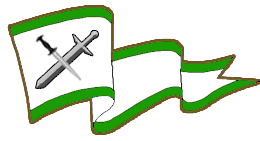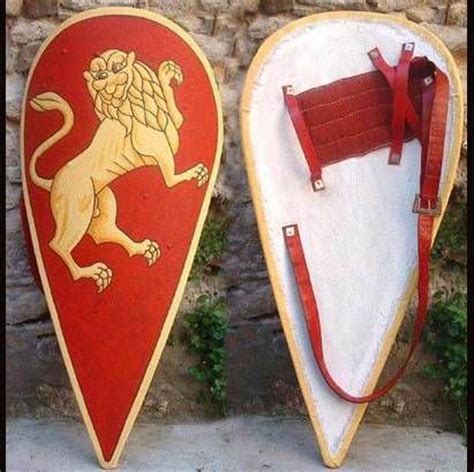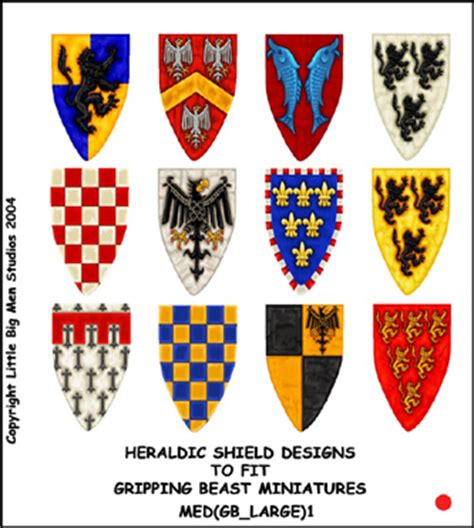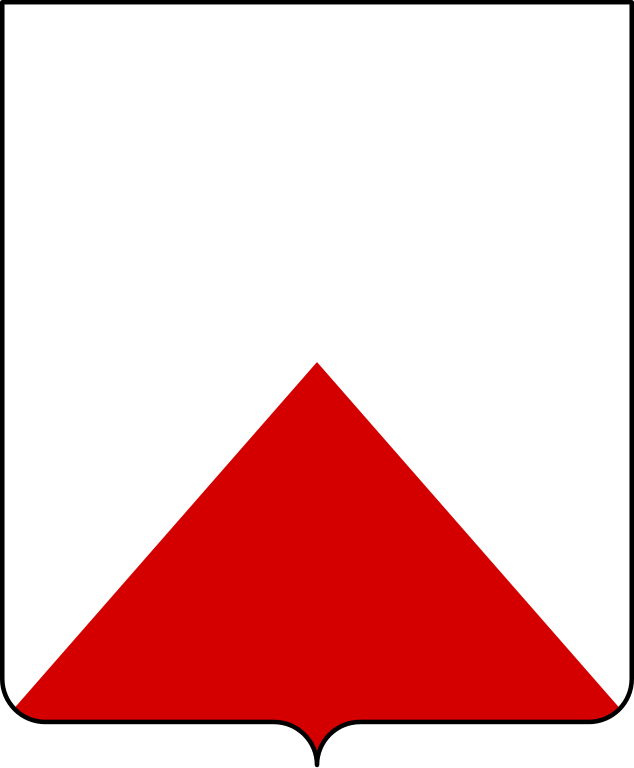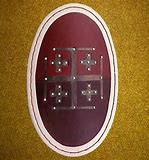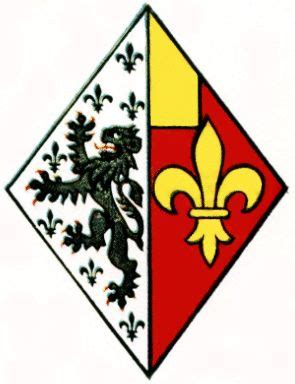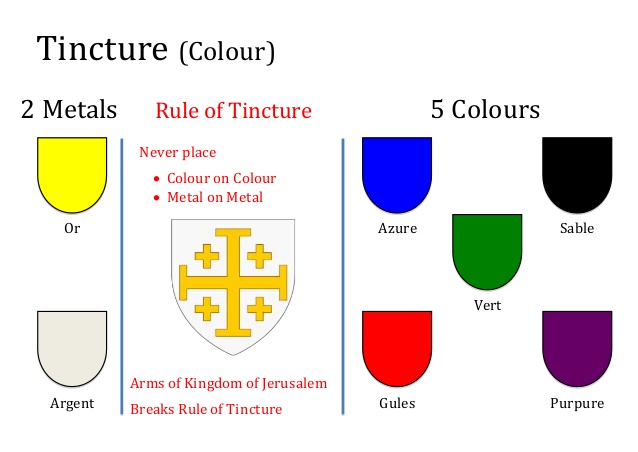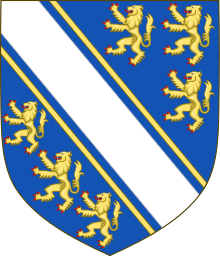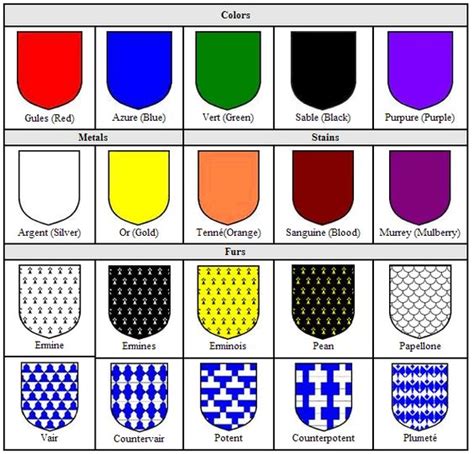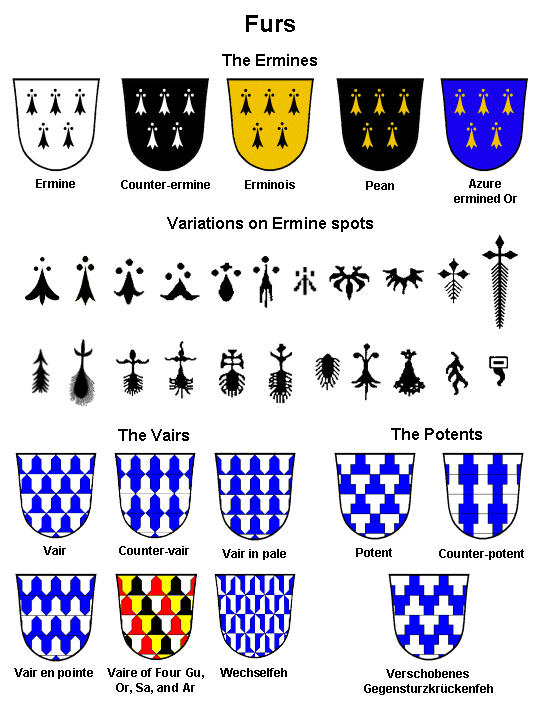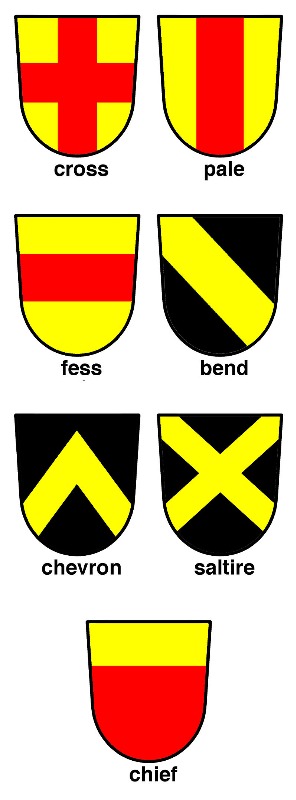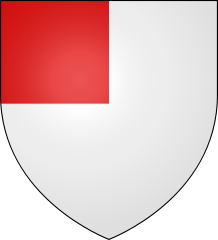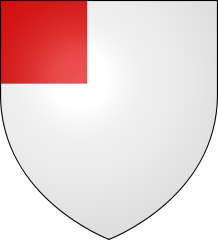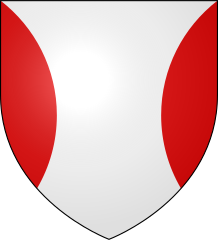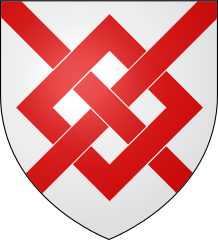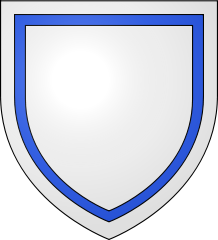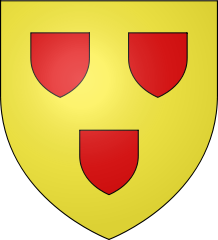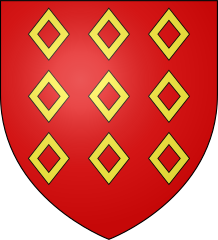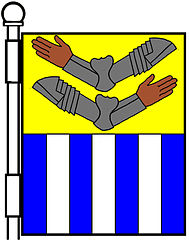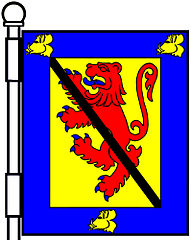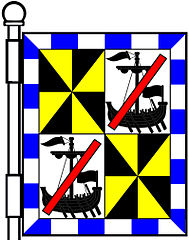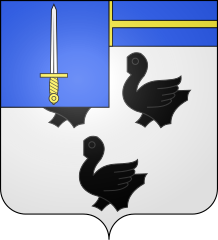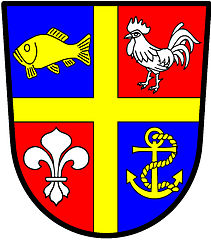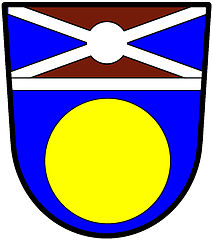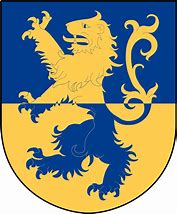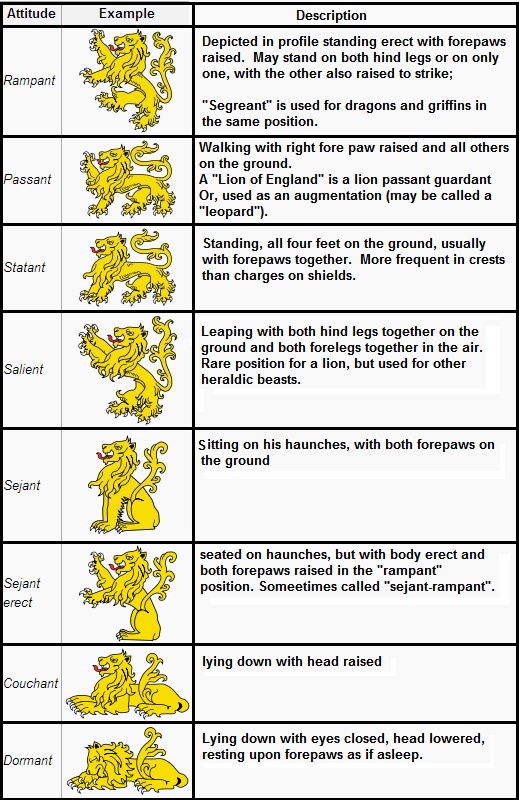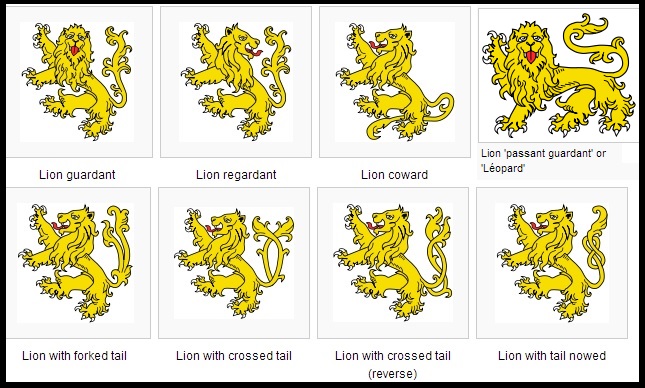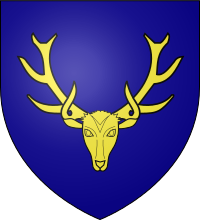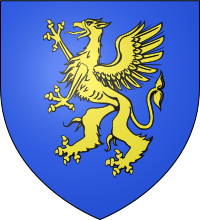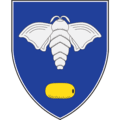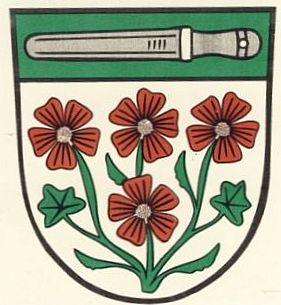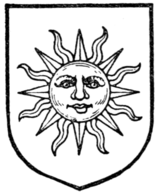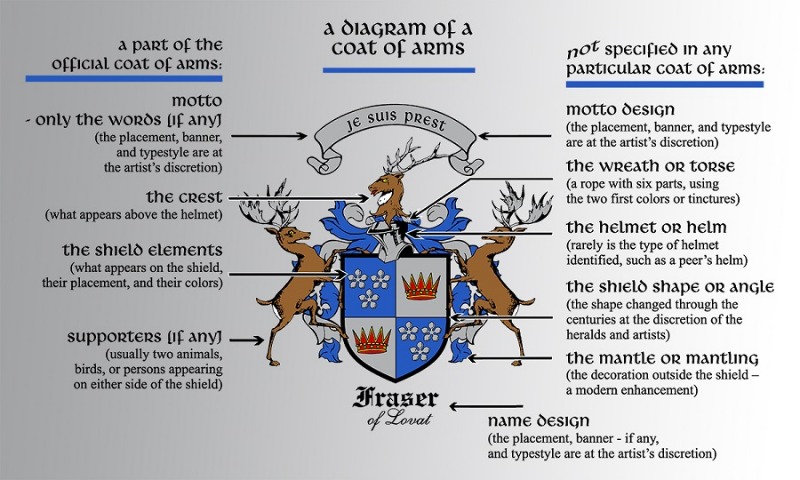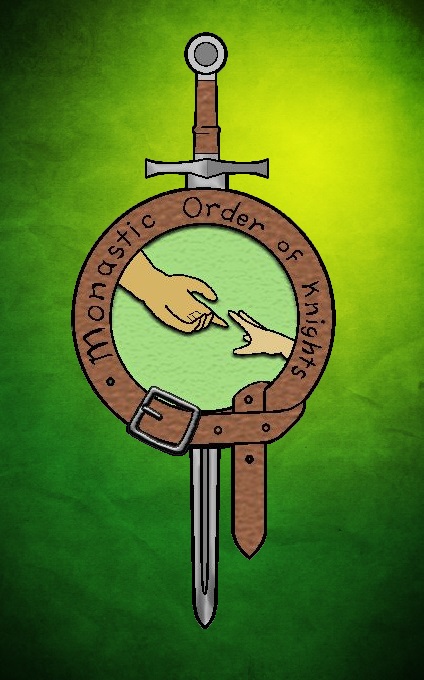- Forum
- Membership Forums
- Guild Hall
- Heraldry
- Journeyman Lessons
- Heraldic Achievement Lessons for the Herald Journeyman
Heraldic Achievement Lessons for the Herald Journeyman
- Posts: 940
- Thank you received: 497
A Brief History of Heraldry
Imagine for a moment the first time you saw a coat of arms…a magnificent shield with its vast array of colors, symbols, and different shapes, with elegant and regal decorations that seem to wrap themselves around it; all tell a particular story, a history. With each variation that comes down to us, we see a familial heritage that not only captures a moment in time, it tells us of the mindset of the bearer and what values were important at the time. As times changed and centuries passed, this particular form of art and story stayed with us. It is for this reason that Heraldry has been referred to as the “handmade of history.” [1] Let me give you a brief overview of it from a historical context, as well as provide a foundation for understanding what makes up the Heraldic Achievement, the fully displayed coat of arms.
Early History
The idea of identifying the most important people on the chaotic field of battle goes back millennia. Kings, generals, commanders, etc., all needed to be readily identifiable in the confusion that would ensue. As gallantry in battle became more associated with rulership and nobility, the symbols of a valiant warrior would come to be used to identify great kings and military leaders. We find some of the earliest use of standards coming out of Ancient Egypt and Mesopotamia. In Egypt, we can find depictions of men carrying the standards of pharaohs and gods going back to the time of King Narmer in 3100 BC, while in ancient Mesopotamia, depictions of similar standards were decorated with fantastic beasts. These would serve as a foundation for future styling and decorations on shields and battlefield identifications. [2] Some other fantastic early examples come from the Phoenicians, Babylonians, Greeks, Romans, and Ancient Chinese, just to name a few.
Medieval Era
What we think of as Heraldry however really begins to take shape in the medieval period, sometime during the 11th or 12th century. It is thought that with the propagation of the Crusades, the ideas of standard identification of arms become more prominent with the amassing of large armies. It is at this time that we find the development of a formalized system of identification and creation, as well as the beginnings of official bodies that would bestow honors on those that have been deemed worthy to earn them, the merit system that is incorporated into each. There is a ton of information out there concerning Heraldry. You can check out the couple of references that I have here, or venture into other areas if you are interested.
Composition of the Heraldic Achievement
So, now that we have a little bit of history, let’s take a look at and briefly cover the different parts of the Heraldic Achievement, what we commonly refer to as the coat of arms.
Shield and Components
Shield (Escutcheon): This is the primary element of the heraldic achievement, without which, there would be no coat of arms. It may come in several different shapes and is divided up into subsections based on use or expression.
Field: This is the main background area that may be solid or divided up into various sections or patterns. It is composed of one or more tinctures, (colors or metals) or furs.
Ordinaries: This is the manner in which the shield is subdivided; these are similar to Divisions. A lesson on this will follow that will be in greater details
Charges: An emblem or a device occupying the field within a shield. There will also be a lesson on these.
Divisions: Similar to Ordinaries, these were intended to create further distinctions in the presentation of one’s arms to keep them distinct from another’s.
External Field
Dexter and Sinister: Refers to right and left sides of the shield. Dexter is Latin for right, and Sinister is Latin for left. All directions are in relation to the bearer.
Alternative Motto/Slogan (Battle Cry): This is a secondary motto and is often used in Scottish Heraldry.
Crest: This is a feature of heraldic design that is displayed above the helm and come from an accessory that knights would wear at tournament. After the 16th century, their actual use fell out of favor and they were primarily depicted in heraldry thereafter.
Torse: This is a wreath of twisted fabric that lays at the base of the crest. No one is sure why it is included, but popular thought or folklore has tied it to the reception of tokens from maidens before tournaments and battle.
Helmet: An aspect granted based on inherent right as a noble with arms. The position and style of the helmet were indicative of the position of the individual and the country or kingdom that they served.
Coronet/Crown: This is the emblem of a monarchical, sovereign state. It is employed under very specific rules. (There will not be any crowns employed on the coats of arms created by Knights here at MOok for use within the Order).
Mantling: This is a drapery that serves as a backdrop for the shield. It represents the protection worn by knights from their helmets to keep warm and dry during inclement weather and decrease injury from warfare.
Order: This area of the Coat of Arms is a designation for special distinction into organizations or awards based on merit. Initially, all coats of arms will contain the symbol for our Order at this location.
Supporter: also referred to as attendants, these are figures that stand on each side of the coat of arms and appear to be supporting it. They are a later addition to the practice of heraldry and come in various figures, each with their own symbolic meaning.
Compartment: A place on which the supporters are depicted standing. Could be grass or rocks, but is generally some sort of landscape.
Motto: This is a maxim, usually in Latin, that sums up the motivations or intentions of an individual, family, or organization.
So, as you can see, there are a lot of different parts that go into the creation of a coat of arms. As we go into each area a little further, we’ll discuss more specific rules on how to construct a coat of arms as well as creating one for your own use that will have the elements that reflect your association with the Order (should you choose to create one).
Since most of your personal history was discussed in the Heritage Lessons, no journal entry is required for this lesson.
References:
S. T. Aveling, Heraldry: Ancient and Modern, including Boutell's Heraldry, Frederick Warne and Company, London and New York (1890), p. 5.
Fox-Davies. A Complete Guide to Heraldry, p. 5.
- Posts: 940
- Thank you received: 497
As we dig just a little more in depth here, let’s start the various styles of the shields in a coat of arms. What began as purely practical designs from a combative point of view turned into a stylized art form that would carry over into the heraldic displays to identify nobility and royalty. While there are many variations of specific types of shields there are some common ones that find their appearance in heraldry quite often We’ll cover a few of those here but know that there are many of them. When deciding which one to use for your own, think about the history of the shield or any meanings that have come to be associated with it throughout the ages. Find something that speaks to you personally and make it your own. What follows are just a couple of the many examples that are out there. Take your time and do some research to find the right shape for your coat of arms.
With these examples, pay attention to the shape of each, not the decorative aspects. We’ll discuss those in other lessons.
Kite Shield (Almond Shield):
This tear drop shaped shield is commonly associated with the Normans. This shield was in use in Europe and the Middle East in the 10th-13th centuries, but may have much earlier origins in the Norse lands. It was designed for cavalry and provide extra protection to mounted riders. We find depictions of in 11th century artwork, particularly Norman, Byzantine, Fatimid Caliphate, and the Rus of Kiev. These would be replaced by a flat topped version and later on, smaller, more compact heater shields. If you have a connection to the Normans or Horse Riding, this may be a shield style to consider for your coat of arms.
Heater Shield:
This is a derivative of the Kite Shield and became popular in the late 12 century for European Use. Their name is derived from their resemblance to the medieval clothes iron and were popular in tournaments and close quarters sword combat. The tops of the shield varied in shape and often has sections cut out for the use of lances. It is the most common form.
Modern French:
This shield finds its origins in the 16th century and was thought to be derived from tournament shields. This is a popular style of heraldry shield that is still used today.
Cartouche (Oval):
This name is derived from the Egyptian Hieroglyph used to denote the name of a pharaoh. It is oval in appearance and finds its beginnings in 15th century heraldry although the shield it derives from is much older and serves as a replacement to the tear drop shaped Kite Shield styles.
Lozenge (Diamond):
Traditionally, the Lozenge was associated with female coats of arms. It provided a way for a non-warfare class of nobility to display their family heraldry.
These are just a few of the many different styles of shape that go into the design of an escutcheon. Put some thought into how you would like yours to be. Try a few out and see which one or ones you find most attractive. As always do some of your own research and take a look to see what else is out there. I’ll provide some links in another thread for you to keep on exploring! When you're finished, share what you learned and what you picked in your journal.
References:
S. T. Aveling, Heraldry: Ancient and Modern, including Boutell's Heraldry, Frederick Warne and Company, London and New York (1890).
Fox-Davies, A.C. A Complete Guide to Heraldry. No date.
- Posts: 940
- Thank you received: 497
We briefly went over some different shapes that come up in heraldry and now we will talk about colors. First thing we must discuss before getting into the different colors and meanings is what is considered the most basic rule in all of heraldry: The Rule of Tincture.
The Rule of Tincture states that:
This means that the colors gold and silver (yellow and white in heraldry colors) cannot be placed on top of one another while black, green, blue, red, or purple cannot be placed on top of one another. There are certain exceptions to this rule to include the use of furs, but it is rigidly followed by modern heralds and as members of the Herald’s Guild, we should definitely be aware of it. Take a look at the following illustration that demonstrates the rule and gives an example of a violation:
Look at the following example from the Coat of Arms of Humphrey de Bohun. Here the Rule of Tincture is properly applied:
Here we want you to be aware of the rules and know what they are, but because this isn’t an official coat of arms, we will not be strictly adhering to the Rule of Tincture. To be awarded the Master Herald distinction from the Guild, you will have to create a coat of arms that follows the all of the applicable rules, the Rule of Tincture being one of them. Now, let’s discuss the classes used to give color to coats of arms.
Basic Colors:
These are the original colors that came to be associated with coats of arms. These along with metals make up the earliest examples of heraldic workmanship.
Black – Sable: Signifies wisdom, grief, constancy and prudence.
Green – Vert: Signifies abundance, joy, hope and loyalty in love.
Blue – Azure: Signifies loyalty, chastity, truth, strength and faith.
Red – Gules: Signifies magnanimity, military strength, warrior and martyr.
Purple – Purpure: Signifies temperance, regal, justice, royal majesty, and sovereignty.
Metals:
These colors come from the natural materials available for shield construction as well as those which would have been available to wealthy individuals. In terms of heraldry, the metals come to represent the colors white and yellow in terms of color.
Silver / White – Argent: Signifies truth, sincerity, peace, innocence and purity.
Gold – Or: Signifies wisdom, generosity, glory, constancy and faith.
Stains:
These blended colors make their appearance in later coats of arms.
Maroon / Blood Red – Sanguine / Murray: Signifies Fortitude or victorious.
Orange – Tenne / Tawny: Signifies ambition.
Furs:
Furs are used to denote nobility and royalty. There are many different styles and variations. Here are five of the most common ones:
Ermine: white field with black spots. Symbolizes valor, justice, and dignity.
Ermines: Black field with white spots. Also symbolizes valor, justice, and dignity.
Erminois: Gold field with black spots. Also symbolizes valor, justice, and dignity.
Pean: Black field with gold spots. Also symbolizes valor, justice, and dignity.
Vair. Blue and white. Symbolizes great wealth.
There are many others, take some time to check them out. As you begin to think about colors for your coat of arms, think about the traits you exhibit, or the traits that you find important to exhibit. What virtues do you associate with yourself? What virtues would someone close to you that knows you well associate with you. Spend some time thinking about this and share your thoughts in your journal.
References:
Fox-Davies, A.C. A Complete Guide to Heraldry. No date.
- Posts: 940
- Thank you received: 497
Now that we have discussed colors of the field, I wanted to touch on divisions of the field. This is the manner in which an Escutcheon is divided up in order to convey information. It creates mini fields inside the overall field.
There are many common ways to divide up the field. Here are the most common (Information collected from Wikipedia page on Division of the Field/Heraldry).
Party Per Fess: The escutcheon is divided horizontally in half.
Party Per Pale: Divided vertically in half.
Party Per Bend: Divided diagonally from upper left to lower right.
Party Per Bend Sinister: Divided diagonally from upper right to lower left.
Party Per Saltire: Divided diagonally both ways.
Party Per Cross or Quarterly: Divided vertically and horizontally into 4 quarters.
Party Per Chevron: Divided in the manner of a chevron.
Party Per Pall: Divided into three parts in a “Y” shape.
The Party Per Fess is a straight line generally, but sometimes will come in many different shapes along the horizontal. Here is a link that describes this feature in much more detail and gives examples of the different styles that have been used.
As you become familiar more familiar with these different ways of dividing up your shield, think about how much information you want to share. Do you come from a noble line and you want to share their arms as part of yours or different virtues that you find important enough to display as your own? Begin thinking about how you would like to divide up your field and what story you want your arms to tell. Share these thoughts in your journal.
- Posts: 940
- Thank you received: 497
Now that we have discussed divisions of the field, there are some basic geometric shapes that find their place on escutcheons along the boundaries of divisions. These can be classified into two main categories: Ordinaries and Sub Ordinaries. Let's talk about each.
Ordinaries:
These are simple geometric shapes that resemble the divisions on the field, but are considered objects on the field rather than just simple lines of division, a small but important distinction. The are composed of straight lines that run the length of the field and with the exception of a few, occupy the center of the field. Here are some examples of the most common ordinaries:
Pale: A vertical stripe right down the center of the shield. Typically 1/5 to 1/3 the width of the shield.
Fess: A horizontal stripe, occupying the middle of the field. Typically 1/5 to 1/3 the width of the shield.
Cross: A Fess with a Pale Combined in the shape of a cross.
Bend: A band extending from the bearer's upper right to lower left.
Bend Sinister: A band extending from the bearer's upper left to lower right.
Chevron: An inverted v-shaped band occupying the center of the shield.
Saltire: A Bend and Bend Sinister Combined in the shape of an "X".
Chief: A horizontal band across the top of the shield.
Chief Triangular: begins in the corners and extends to a point that is one quarter to one third the way down the shield.
Chief Enarched: is drawn with a concave arch.
Chief Double-arched: has two concavities.
Subordinaries:
These are lesser geometric figures and are not considered honorable ordinaries. They are considered so because they do not stretch the length of the field. They are divided into two sub categories: Fixed and mobile. A fixed subordinary doesn't move. It is in the same place always. We'll cover this one first.
Quarter: Covers the bearer's upper right quarter of the shield.
Canton: Like a quarter but the area covered is smaller.
Flaunches: A circular arc emerging from the sides of the shield. Always in pairs.
Fret: An interlacing bendlet, bendlet sinister, and mascle. A bendlet is a thinner version of the bend, and a mascle is the diamond band that goes around the center.
Orle: A border produced outside the shield.
There are many other variations on fixed subordinaries. Do some research and see if there are any others that might be of interest. Here are a couple of the mobile subordinaries. Unlike the fixed subordinaries, these can appear anywhere on the field.
Escutcheon: The shield is a popular mobile subordinary and it can be displayed many times often occupying the center of the shield.
Lozenge: The diamond is also a popular mobile subordinary and can come in any number and size in the field.
Roundel: A circle, disk, or ball. Can come in any number or size in the field.
Billet: A small rectangular shape, like a letter. Can be displayed in any number, vertically or horizontally.
These are just a few of the Ordinaries and Subordinaries available for use. Take some time to look through these and see what looks fitting for you. Do some research on your own and see if you can draw on any meanings for some of these that might make a connection to you. As always have fun and share what your doing!
- Posts: 940
- Thank you received: 497
This is an additional element to talk about that ties in with the previous lesson. What happens when someone wants to use two or more ordinaries on a coat of arms? This style is called a Diminutive and can be an interesting way to add an attractive appearance to your escutcheon.
Typically, a Diminutive will take place along the line of ordinary and as such are categorized that way. In the following examples, I'll provide an illustration of one particular diminutive for each. It's up to you to check out the other examples. Let's get started.
Diminutives of the Pale:
Pallet: Typically, and band half the width of the pale.
Endorse: A band half the width of the pallet, also found in pairs on either side of the pale
In the example, it demonstrates the Pallet, with alternating blue and white lines.
Diminutives of the Fess:
Bar: Band half the width of the Fess.
Barrulet: Band narrower than half the width of the Fess.
Harmade: A bar coupled that doesn't reach the edge of the field, usually in threes.
In the example, it demonstrates the Harmade style with three bars that do not extend to the edge of the shield.
Diminutives of the Bend:
Bendlet: Half the width of the bend.
Ribbon: Half the width of a bendlet. Also referred to as a cost.
Baton: A bendlet coupled that doesn't reach the ends of the shield.
In the example, this demonstrates the ribbon extending from the bearer's top right to the bearer's bottom left.
Diminutives of the Bend Sinister:
Bendlet Sinister: Band that is half the width of the bend sinister.
Baton Sinister: A Bendlet Sinister Coupled.
In the example, this is a Baton Sinister, with red batons rising from bearer's bottom right to top left in two of the quartered sections.
Diminutives of a Chevron:
Chevronel: half the width of a chevron.
Couple Close: half the width of a chevronnel, but only to be found in pairs with a chevron between them.
In the example, this is a Couple Close style surrounding the larger chevron.
Diminutives of Chief:
Comble: Half the width of a Chief.
Chief Enhanced: Also half the width of a Chief. Indistinguishable from Comble.
Fillet: Similar to a Barrulet, it takes on the characteristics of a Chief but does not extend to the ends of the shield.
The example is the Comble Style of Chief Diminutive with the Bearer's upper left portion making this distinction.
Diminutive of the Cross:
Cross Fillet: Less than half the width of the cross.
There is one style to choose from here, although there are examples where the cross doesn't stretch the length of the shield.
Diminutives of the Saltire:
Fillet Saltire: Bands less than half the width of the saltire.
Saltorel: A coupled saltire, normally three or more.
In the example provided, this is a Fillet Saltire, with the Saltire in the upper portion of the shield only occupying less than half of the usual space.
So many styles, so many variations and this is just the layout, coloring, and divisions of a escutcheon. In the next several lessons we will cover charges, decorative ornaments that add additional meaning or convey ideas about the bearer
- Posts: 940
- Thank you received: 497
Charges are emblems that occupy part of the escutcheon. Technically, Ordinaries and Subordinaries are considered charges based on specific geometric shapes. What the next few lessons will cover are categories of Charges that are popular in Heraldic decoration. Charges carry meaning and symbolism and can mean different things based on how they are displayed. As you go through these lessons think about what the positioning means, and what applies to you. This first lesson will cover the use of the Lion, one of the most popular Heraldic Charges in use.
The Lion:
The lion is one of the most commonly used charges. Traditionally, it has been associated with courage, nobility, royalty, strength, stateliness, and valor since there is a traditional association with lions and “kingliness.” [1] We find the lion in symbolism going back to the early Christian era, and see its regular appearance in heraldry in the 12th century. [2] It would go on to become a popular Charge associated with chivalry because it was not considered restricted to royal coats of arms and how strong connotations regarding courage and valor.
As part of displaying the Charge on the shield, one task was to determine what position or “attitude” meant certain things in regard to the charge. If the charge is an animal, is it seated, standing, or walking? Is it attacking or defending? Is it lazy or asleep? These were all heraldic consideration to the medieval herald and each carried its own meaning. Here is a couple of charts with popular attitudes associated with the lion:
Definitions:
Rampant: Means to rear up, and can be displayed with lion looking forward, looking over shoulder (Guardant), or looking behind (Regardant).
Passant: Means to stride, and can also be displayed in the same manner as Rampant (forward, Guardant, and Regardant).
Sejant: Means seated. Is normally displayed in forward looking pose, or sejant erect, a seated version with its front paws raised in Rampant.
Couchant: Means lying down but with head raised. Displayed looking forward.
Courant: Means in full chase and is depicted looking forward at full stride with all four legs in the air.
Coward: A display in rampant with a tail between its legs.
Dormant: Means sleeping and is displayed lying down with eyes closed resting on forepaws.
Salient: Means springing and is displayed with both hind legs on the ground and bout front paws in the air looking forward.
Statant: Means standing and is displayed standing on all fours looking forward or in Guardant.
With a few exceptions, mainly to peaceful animals or mythical ones, these positions are standard throughout heraldry. In future lessons, they won’t be readdressed accept when there is a different name referring to the position for a specific animal. The next lesson will address more animals in a general sense, along with their associated symbolism or meaning.
References:
1] Garai, Jana. The Book of Symbols. New York: Simon & Schuster. 1973.
2] Fox-Davies, A.C. A Complete Guide to Heraldry. Kindle Ed. p. 62.
- Posts: 940
- Thank you received: 497
Heraldry uses many different animals in the presentation of the coats of arms. Animals used can be real or mythical and have meanings associated with their usage. For this lesson, I'll be referencing Arthur Charles Fox-Davies and his 1909 work A Complete Guide to Heraldry , still considered the authoritative text on heraldry. Here are some of the most common categories of animals:
Beasts:
Beasts in Heraldry covers the four legged animals to include lions. Here, we will find tigers, leopards, antelope, deer, camels, etc. Here is a reference link to Fox-Davies' work concerning Beasts:
Mythical Beasts:
In this category, we come face to face with mythical creatures including griffons, dragons, unicorns, etc. The type of beast was stylized based on the culture that was producing the image. We find dragons and griffons being the most prominent of the mythical creatures portrayed. Here is a link to the Complete Guide to Heraldry for further information:
Birds:
There are many variations and species of bird used in heraldry with the eagle being the most common. They symbolize Pride, Peace, and Freedom. Here is a link to the Complete Guide to Heraldry reference where the author discusses this charge in great detail:
Fish:
Fish are another popular heraldic charge that symbolize Unity, Virtue regardless of heritage, truth, and generosity. Some also take on symbols of power and swiftness, depending on the one used. For more information, take a look here:
Reptiles:
One would be remiss to not include a section on reptiles for heraldry. Snakes and lizards of all types have been symbols wisdom throughout the ages and have a prominent home in the history of heraldry. Here's some more information on the topic:
Insects:
Insects can be found in many different coats of arms throughout history. Butterflies, grasshoppers, dragonflies, bees, etc., all are used in many different ways. To read more about this charge check out the following link:
By no means is this list exhaustive, but it does do a good job of covering the general bases of animals used in heraldry. I'll include a link at the bottom that has more of the meanings associated with different animal charges if you have one in particular that you have an affinity for. Take some time to look through these and get familiar with their meanings. In the next lesson, we'll wrap up the lessons on charges by covering plants and objects that also find a place in heraldry.
- Posts: 940
- Thank you received: 497
In this final lesson on Charges, we'll briefly cover the remaining categories not covered in the previous lessons. The first category is that of Plants. They appear in the field as flowers, fruit, leaves, or trees.
Flowers have been used in heraldry since the beginning and can take on a style reminiscent of their actual appearance or a more symbolic version that would go on to be equated with them, such as the Fleur de Lis. This latter symbol would go on to be included in the Achievements of royalty, particularly those of French lines.
Trees and their leaves are also important and used frequently in this category. The various species of trees have developed associated meanings throughout history, and continue to be implemented in Heraldry for these meanings. Although tree styles appear similar, all varieties are used. If no variety is specified in the achievement, oak, the most common tree used, is generally regarded as the model used for display.
Here is a reference to A Complete Guide to Heraldry that covers the nature of plants in Heraldic Achievements:
Moving on from the various plant charges, we come to the rather broad category of inanimate objects. It should be noted that any inanimate object can be converted into a charge but there are some common ones that appear regularly in history. These include Anchors, Anvils, Castles, Celestial Objects, Geometric Shapes, Arrows, Swords, Torches, etc., etc. These developed from a rise in trades, militaristic association, or links to esoteric knowledge. That being said, there is a tremendous amount of symbolism associated with this category of charges.
For some follow up information, check out the link in A Complete Guide to Heraldry:
As we conclude these lessons on Charges, a lot of legwork rests with you as you explore the various meanings associated with each of these categories. As you go through them, you may find several that resonate with you, or take on some deeper meaning for you. Take the time to familiarize yourself with them
- Posts: 940
- Thank you received: 497
Now that we have completed the lessons on the Escutcheon, let's briefly reexamine those elements that find their home in the external field of the Achievement.
Alternative Motto/Slogan (Battle Cry): This is a secondary motto and is often used in Scottish Heraldry and is found at the top of an Achievement.
Crest: This is a feature of heraldic design that is displayed above the helm and come from an accessory that knights would wear at tournament. After the 16th century, their actual use fell out of favor and they were primarily depicted in heraldry thereafter.
Torse: This is a wreath of twisted fabric that lays at the base of the crest. No one is sure why it is included, but popular thought or folklore has tied it to the reception of tokens from maidens before tournaments and battle.
Helmet: An aspect granted based on inherent right as a noble with arms. The position and style of the helmet were indicative of the position of the individual and the country or kingdom that they served.
Coronet/Crown: This is the emblem of a monarchical, sovereign state. It is employed under very specific rules. (There will not be any crowns employed on the coats of arms created by Knights here at MOoK for use within the Order).
Mantling: This is a drapery that serves as a backdrop for the shield. It represents the protection worn by knights from their helmets to keep warm and dry during inclement weather and decrease injury from warfare.
Order: This area of the Coat of Arms is a designation for special distinction into organizations or awards based on merit. Initially, all coats of arms will contain the symbol for our Order at this location.
Supporter: also referred to as attendants, these are figures that stand on each side of the coat of arms and appear to be supporting it. They are a later addition to the practice of heraldry and come in various figures, each with their own symbolic meaning.
Compartment: A place on which the supporters are depicted standing. Could be grass or rocks, but is generally some sort of landscape.
Motto: This is a maxim, usually in Latin, that sums up the motivations or intentions of an individual, family, or organization. It is generally found at the bottom of an Achievement.
Take your time with this. Many of these external features have different associated meanings that vary on country of origin, lines of nobility, and even the use of a particular motto. One feature may hold a particular meaning to you that revealed itself after you discovered some of the history of your family line. This all lends itself well to the creation of something truly personal that is also a snap shot of you for others to see. Have fun with it!
- Forum
- Membership Forums
- Guild Hall
- Heraldry
- Journeyman Lessons
- Heraldic Achievement Lessons for the Herald Journeyman
